Energy and Environmental Analysis of Single-Family Houses Located in Poland
Abstract
1. Introduction
2. Background on Building Energy Modeling and Life Cycle Assessment
2.1. Life Cycle Assesment
2.2. Life Cycle Costs
2.3. Thermal Comfort
2.4. Research Gap and the Aim of this Research
3. Methods
3.1. Research Object
- BSTD—Brick building that meets standard requirements,
- BPASS—Brick building that meets the requirements of heat transfer coefficients for passive buildings,
- WSTD—Wood building that meets standard requirements,
- WPASS—Wood building that meets the requirements of heat transfer coefficients for passive buildings.
3.2. Thermal Model of the Building
3.3. Thermal Comfort
3.4. Ventilation
- the windows are only opened to lower the temperature of the room, i.e., the outside temperature Tout must be lower than the temperature of the room Tin (dTin_out = Tin−Tout> 0). The degree of window opening will depend on the value of dTin_out. The window will be opened further for small values and less for large ones,
- the window will be opened if the room has poor thermal comfort (the temperature is too high). The adaptive comfort model based on the EN15251:2007 standard [31] was adopted in this paper. Therefore, the comfort parameter will be the operative comfort temperature (Totc). The difference between the operating room temperature (Toin) and Totc (dTin_tc = Toin−Totc> 0) will indicate if the room temperature is too high in relation to the optimal (comfortable) temperature. For larger dTin_tc values, the window will be opened further than for small values,
- each window has three areas that can be opened. This will be calculated as the product of a certain coefficient (C, which can take three values (Wk, k = 1,2,3)—which is identical for all of the windows) and the total area of the window Aj (j = 1, …, the number of windows),
- the window opening area will change at certain times (on weekdays: 6, 8, 15, 18, 22, on weekends: 8, 11, 14, 17, 18, 22). In between the abovementioned hours, the windows will be fixed,
- the windows will be assumed to be closed if there are no residents in the building,
- the maximum allowable air change rate ACHmax = 10 h−1.
- the total number of thermal discomfort hours (Hdis, h). It was assumed that this will be the number of hours where the thermal comfort is outside the 2nd category of climate in the adaptive model [31],
- the building’s heat demand (Qheat, kWh).
3.5. The Life Cycle Costs
3.6. The Global Warming Potential (Greenhause Gases)
4. Results
4.1. The Global Warming Potential Analysis
4.1.1. Greenhouse Gas Emissions from the Building Structure
4.1.2. Greenhouse Gas Emissions from Heating
4.2. The Life Cycle Costs Analysis
4.3. Thermal Comfort Analysis
5. Discussion
6. Conclusions
- Considering the costs of erecting a house in both brick and wooden technology, it should be stated that the lower cost investment is the one that uses wooden construction materials; this is due to the lower costs of these materials. However, it should be remembered that some of these savings will be offset by additional expenses, such as the need to employ specialized construction workers who have experience in erecting such buildings, among others. However, even the wooden building meets the insulation requirements; as for passive houses (which have higher insulation costs) they may be more cost-effective than a brick building that only meets the minimum insulation requirements (lower insulation costs);
- Due to the lower LCC and lower GHG emissions, houses made using wooden technology can be seen as more attractive. Unfortunately, wooden buildings are worse than brick buildings in terms of thermal comfort as there are a greater number of thermal discomfort hours (up to twice the number of hours);
- Increasing the insulation thickness of the external partitions beyond the standard value will reduce the instantaneous heat loss in winter, however, due to the higher investment costs, the life cycle costs are only lower in the case of buildings with expensive to operate heat sources (e.g., an electric boiler); in addition, this can adversely affect the thermal comfort of buildings without an air-conditioning system in the summer; if it is decided to insulate the external walls, such as in passive buildings, air-conditioning should be considered in order to meet the thermal comfort requirements;
- The most environmentally friendly heat source, from the point of view of GWP, combines a heat pump and a biomass boiler. The GHG emissions in a building with these sources are on average about 3–4 times lower (depending on the degree of insulation of the external partitions) compared to a building with an electric boiler. Buildings with a gas boiler emit about 1.5 times more GWP on average, compared to buildings with a heat pump. However, in terms of the LCC, buildings with a coal boiler are the best;
- In order to reduce GHG emissions, a house using wooden technology and a heat pump as the heat source should be chosen; in this case, however, larger expenses should be planned for at the investment stage, but in the longer term, the total costs will be no more than 5% higher than the costs of the same building with the cheapest to operate heat source—a coal boiler;
- Houses that use electricity from the grid for heating generate the largest amount of GWP, regardless of the technology used to build them. Renewable energy sources, such as a heat pump with photovoltaic panels and a biomass boiler, reduce the investment and operation expenditure by 11–25%, depending on the type of building in relation to the total LCC in the same buildings with an electric boiler.
Limitations and Future Research
Author Contributions
Funding
Acknowledgments
Conflicts of Interest
Appendix A
| Resource Name | Quantity (STD/PASS) | Environment Data Source | Environmental Product Declaration (EPD) Program | Environmental Product Declaration (EPD) Number | Date |
|---|---|---|---|---|---|
| Acrylic emulsion paint, for exterior application | 627.9 kg | EPD Jotashield Antifade Colours, P.T. Jotun Indonesia Jotun A/S | EPD Norge | NEPD-1736-712-EN | 2019 |
| Ceramic tiles | 159.3 m2 | EPD Italian Ceramic Tiles | Institut Bauen und Umwelt e.V. | EPD-COI-20160202-ICG1-EN | 2016 |
| EPS foam insulation | 8.0/24.0 m3 | EPD Expanded Polystyrene (EPS) Foam Insulation (density 15 kg/m³) EUMEPS | Institut Bauen und Umwelt e.V. | EPD-EUM-20160269-IBG1-EN | 2017 |
| Floor screed mortar, cement screed | 12.3 m3 | Oekobau.dat 2017-I, EPD Mineralische Werkmörtel: Estrichmörtel Zementestrich quickmix Gruppe GmbH & Co. KG | Institut Bauen und Umwelt e.V. | EPD-QMX-20160208-IBC1-DE | 2014 |
| Glass wool insulation, unfaced | 6.7 m3 | EPD Frame-S37 | International EPD System | S-P-00661 | 2016 |
| Gypsum plaster for internal walls and ceilings | 5.1 m3 | Gypsum plasters ALFA, BETA, GAMMA, ZETA, SPRINT, TEMPO, Dolina Nidy 2014 | Instytut Techniki Budowlanej | ITB EPD No 17/2014 | 2014 |
| Gypsum plasterboard | 4.7 m3 | Gypsum plasterboard, Rigips PRO and Rigips 4PRO, SaintGobain 2014 | Instytut Techniki Budowlanej | ITB EPD No 25a | 2014 |
| Hollow core concrete slabs, generic | 34.0 m3 | One Click LCA | One Click LCA | - | 2018 |
| Insulation, EPS facade panel | 27.0/73.6 m3 | EPD ALLIGATOR FARBWERKE GmbH Dalmatiner Fassadendämmplatte 032 | Institut Bauen und Umwelt e.V. | EPD-DAW-20152319-CBD1-DE | 2016 |
| Insulation, XPS | 2.6 m3 | XENERGYTM XPSDämmplatte Dow Deutschland GmbH & Co. OHG | Institut Bauen und Umwelt e.V. | EPD-DOW-2013111-D | 2013 |
| Inward-facing window, with wooden frame | 30.4 m2 | EPD Gilje innadslående eXtra vindu Gilje Tre AS | EPD Norge | NEPD-1835-789-EN | 2019 |
| Lightweight bituminous underlays for roof waterproofing | 265.5 m2 | EPD Lightweight underlays For Roof Waterproofing—sector EPD | International EPD System | S-P-01329 | 2018 |
| Membranes, FPO/PVC-P waterproofing reinforced with polyester net | 159.3 m2 | EPD for Mapeplan TM—Mapeplan TB, Mapeplan Taf—Mapeplan TI | International EPD System | S-P-00906 | 2016 |
| OSB panels | 1.8 m3 | Oekobau.dat 2017-I, EPD SWISS KRONO OSB Panels SWISS KRONO Tec AG | Institut Bauen und Umwelt e.V. | EPD-KRO-20150067-IBD2-EN | 2015 |
| Ready-mix concrete, normal-strength, generic | 22.3 m3 | One Click LCA | One Click LCA | - | 2018 |
| Rock wool insulation, for ventilated facades and cavity walls | 16.0/26.5 m3 | EPD FPL-035/FPL-035-GS/KD-035/KD-035-GS Rock Mineral Wool for ventilated facades and cavity walls Knauf Insulation | Institut Bauen und Umwelt e.V. | EPD-KNI-20150327-CBB1-EN | 2016 |
| Sandstone cladding, natural | 17.7 m3 | Dichiarazione ambientale di prodotto: rivestimento in pietra serena di firenzuola con superficie naturale e sabbiata con bordi rifilati | EPD Italy | EPDITALY0065 | 2019 |
| Wall bricks | 70.5 m3 | Oekobau.dat 2017-I, EPD Mauerziegel Arbeitsgemeinschaft Mauerziegel | Institut Bauen und Umwelt e.V. | EPD-AMZ-20140244-ICG1-DE | 2015 |
| Wooden entrance door | 1.8 m2 | EPD Climate door / interior door Nordic Dørfabrikk AS | EPD Norge | NEPD-1535-525-EN | 2018 |
| Resource Name | Quantity (STD/PASS) | Environment Data Source | Environmental Product Declaration (EPD) Program | Environmental Product Declaration (EPD) Number | Date |
|---|---|---|---|---|---|
| Acrylic emulsion paint, for exterior application | 602.5 kg | EPD Jotashield Antifade Colours, P.T. Jotun Indonesia Jotun A/S | EPD Norge | NEPD-1736-712-EN | 2019 |
| Ceramic tiles | 158.5 m2 | EPD Italian Ceramic Tiles | Institut Bauen und Umwelt e.V. | EPD-COI-20160202-ICG1-EN | 2016 |
| EPS foam insulation | 4.2/20.3 m3 | EPD Expanded Polystyrene (EPS) Foam Insulation (density 15 kg/m³) EUMEPS | Institut Bauen und Umwelt e.V. | EPD-EUM-20160269-IBG1-EN | 2017 |
| Floor screed mortar, cement screed | 8.4 m3 | Oekobau.dat 2017-I, EPD Mineralische Werkmörtel: Estrichmörtel Zementestrich quickmix Gruppe GmbH & Co. KG | Institut Bauen und Umwelt e.V. | EPD-QMX-20160208-IBC1-DE | 2014 |
| Glass wool insulation, unfaced | 12.6 m3 | EPD Frame-S37 | International EPD System | S-P-00661 | 2016 |
| Glass wool/mineral wool insulation, panel | 4.8 m3 | Rock mineral wool (Factory Gliwice), Saint Gobain Isover 2013 | Instytut Techniki Budowlanej | EPD Rock mineral wool (Factory Gliwice) | 2013 |
| Gypsum plasterboard | 8.7 m3 | Gypsum plasterboard, Rigips PRO and Rigips 4PRO, SaintGobain 2014 | Instytut Techniki Budowlanej | ITB EPD No 25a | 2014 |
| Hardwood studs | 13.5 m3 | The Australian Life Cycle Inventory Database Initiative (AusLCI) | AusLCI | - | 2018 |
| Hollow core concrete slabs, generic | 8.8 m3 | One Click LCA | One Click LCA | - | 2018 |
| Insulation, EPS facade panel | 12.1/43.6 m3 | EPD ALLIGATOR FARBWERKE GmbH Dalmatiner Fassadendämmplatte 032 | Institut Bauen und Umwelt e.V. | EPD-DAW-20152319-CBD1-DE | 2016 |
| Insulation, XPS | 2.6 m3 | XENERGYTM XPSDämmplatte Dow Deutschland GmbH&Co. OHG | Institut Bauen und Umwelt e.V. | EPD-DOW-2013111-D | 2013 |
| Inward-facing window, with wooden frame | 30.4 m2 | EPD Gilje innadslående eXtra vindu Gilje Tre AS | EPD Norge | NEPD-1835-789-EN | 2019 |
| Lightweight bituminous underlays for roof waterproofing | 265.5 m2 | EPD Lightweight underlays For Roof Waterproofing—sector EPD | International EPD System | S-P-01329 | 2018 |
| Membranes, FPO/PVC-P waterproofing reinforced with polyester net | 84.5 m2 | EPD for Mapeplan TM—Mapeplan TB, Mapeplan Taf—Mapeplan TI | International EPD System | S-P-00906 | 2016 |
| Mineral wool insulation with recycled briquette content | 12.7 m3 | EPD_Isover UNI-AKU | Česká Informační Agentura Životního Prostředí | 3013EPD-15-0392 | 2015 |
| OSB panels | 8.5 m3 | Oekobau.dat 2017-I, EPD SWISS KRONO OSB Panels SWISS KRONO Tec AG | Institut Bauen und Umwelt e.V. | EPD-KRO-20150067-IBD2-EN | 2015 |
| Ready-mix concrete, normal-strength, generic | 22.3 m3 | One Click LCA | One Click LCA | - | 2018 |
| Rock wool insulation panels, unfaced, generic | 15.3/27.2 m3 | One Click LCA | One Click LCA | - | 2018 |
| Sandstone cladding, natural | 17.7 m3 | Dichiarazione ambientale di prodotto: rivestimento in pietra serena di firenzuola con superficie naturale e sabbiata con bordi rifilati | EPD Italy | EPDITALY0065 | 2019 |
| Unbonded, non-combustible blown glass wool/mineral wool insulation | 3.6/15.9 m3 | EPD Supafil and Jet Stream (0.037–0.042 W/mK) blown glass mineral wool insulation, Knauf Insulation 2014 | Building Research Establishment (BRE) | BREG EN EPD000051 | 2014 |
| Wooden entrance door | 1.8 m2 | EPD Climate door / interior door Nordic Dørfabrikk AS | EPD Norge | NEPD-1535-525-EN | 2018 |
References
- ISO Standard ISO14040:2006. Environmental Management—Life Cycle Assessment—Principles and Framework; International Organization for Standardization: Geneva, Switzerland, 2006. [Google Scholar]
- ISO Standard ISO14044:2006. Environmental Management—Life Cycle Assessment—Requirements and Guidelines; International Organization for Standardization: Geneva, Switzerland, 2006. [Google Scholar]
- Gustavsson, L.; Joelsson, A.; Sathre, R. Life cycle primary energy use and carbon emission of an eight-storey wood-framed apartment building. Energy Build. 2010, 42, 230–242. [Google Scholar]
- Blengini, G.A.; Di Carlo, T. The changing role of life cycle phases, subsystems and materials in the LCA of low energy buildings. Energy Build. 2010, 42, 869–880. [Google Scholar]
- Borkowski, M. Assesment of the life cycle of objects on the example of single-family housing. Przegląd Bud. 2015, 3, 15–21. (In Polish) [Google Scholar]
- Lewandowska, A.; Noskowiak, A.; Paichrowski, G.; Strykowski, W.; Witczak, A. Environmental Life Cycle Assessment of Model Wooden and Brick Buildings as an Example of the Application of the LCA Technique; Wood Technology Institute: Poznań, Poland, 2012. (In Polish) [Google Scholar]
- Kale, N.N.; Joshi, D.; Menon, R. Life cycle cost analysis of commercial buildings with energy efficient approach. Perspect. Sci. 2016, 8, 452–454. [Google Scholar]
- Ammar, M.; Zayed, T.; Moselhi, O. Fuzzy-based life-cycle cost model for decision making under subjectivity. J. Constr. Eng. Manag. 2013, 139, 556–563. [Google Scholar] [CrossRef]
- Alsayed, M.F.; Tayeh, R.A. Life cycle cost analysis for determining optimal insulation thickness in Palestinian buildings. J. Build. Eng. 2019, 22, 101–112. [Google Scholar]
- Ascione, F.; Bianco, N.; De Masi, R.F.; Mauro, G.M.; Vanoli, G.P. Design of the building envelope: A novel multi-objective approach for the optimization of energy performance and thermal comfort. Sustainability 2015, 7, 10809–10836. [Google Scholar] [CrossRef]
- Atmaca, A.; Atmaca, N. Comparative life cycle energy and cost analysis of post-disaster temporary housings. Appl. Energy 2016, 171, 429–443. [Google Scholar]
- Braulio-Gonzalo, M.; Bovea, M.D. Environmental and cost performance of building’s envelope insulation materials to reduce energy demand: Thickness optimization. Energy Build. 2017, 150, 527–545. [Google Scholar] [CrossRef]
- Invidiata, A.; Ghisi, E. Life-cycle energy and cost analyses of window shading used to improve the thermal performance of houses. J. Clean. Prod. 2016, 133, 1371–1383. [Google Scholar] [CrossRef]
- Islam, H.; Jollands, M.; Setunge, S.; Haque, N.; Bhuiyan, M.A. Life cycle assessment and life cycle cost implications for roofing and floor designs in residential buildings. Energy Build. 2015, 104, 250–263. [Google Scholar] [CrossRef]
- Jaber, S.; Ajib, S. Optimum, technical and energy efficiency design of residential building in Mediterranean region. Energy Build. 2011, 43, 1829–1834. [Google Scholar] [CrossRef]
- Kaynakli, O. Parametric investigation of optimum thermal insulation thickness for external walls. Energies 2011, 4, 913–927. [Google Scholar] [CrossRef]
- Pal, S.K.; Takano, A.; Alanne, K.; Palonen, M.; Siren, K. A multi-objective life cycle approach for optimal building design: A case study in Finnish context. J. Clean. Prod. 2017, 143, 1021–1035. [Google Scholar]
- Tong, S.; Li, H. Life-cycle cost analysis of roofing technologies in tropical areas. Energy Build. 2017, 151, 283–292. [Google Scholar] [CrossRef]
- Udawattha, C.; Halwatura, R. Life cycle cost of different walling material used for affordable housing in tropics. Case Stud. Constr. Mater. 2017, 7, 15–29. [Google Scholar] [CrossRef]
- Bichiou, Y.; Krarti, M. Optimization of envelope and HVAC systems selection for residential buildings. Energy Build. 2011, 43, 3373–3382. [Google Scholar] [CrossRef]
- Audenaert, A.; De Cleyn, S.H.; Vankerckhove, B. Economic analysis of passive houses and low-energy houses compared with standard houses. Energy Policy 2008, 36, 47–55. [Google Scholar] [CrossRef]
- Chastas, P.; Theodosiou, T.; Kontoleon, K.J.; Bikas, D. The effect of embodied impact on the cost-optimal levels of nearly zero energy buildings: A case study of a residential building in Thessaloniki, Greece. Energies 2017, 10, 740. [Google Scholar] [CrossRef]
- Harkouss, F.; Fardoun, F.; Biwole, P.H. Multi-objective optimization methodology for net zero energy buildings. J. Build. Eng. 2018, 16, 57–71. [Google Scholar] [CrossRef]
- Harkouss, F.; Fardoun, F.; Biwole, P.H. Passive design optimization of low energy buildings in different climates. Energy 2018, 165, 591–613. [Google Scholar] [CrossRef]
- Kang, H.J. Development of an nearly zero emission building (nZEB) life cycle cost assessment tool for fast decision making in the early design phase. Energies 2017, 10, 59. [Google Scholar] [CrossRef]
- Marszal, A.J.; Heiselberg, P. Life cycle cost analysis of a multi-storey residential Net Zero Energy Building in Denmark. Energy 2011, 36, 5600–5609. [Google Scholar] [CrossRef]
- Moran, P.; Goggins, J.; Hajdukiewicz, M. Super-insulate or use renewable technology? Life cycle cost, energy and global warming potential analysis of nearly zero energy buildings (nZEB) in a temperate oceanic climate. Energy Build. 2017, 139, 590–607. [Google Scholar] [CrossRef]
- ANSI/ASHRAE Standard 55. Thermal Environmental Conditions for Human Occupancy; American Society of Heating, Refrigerating and Air-Conditioning Engineers (ASHRAE): Atlanta, GA, USA, 2017. [Google Scholar]
- Fanger, P.O. Thermal Comfort; Danish Technical Press: Copenhagen, Denmark, 1970. [Google Scholar]
- ISO Standard ISO7730:2005. Ergonomics of the Thermal Environment—Analytical Determination and Interpretation of Thermal Comfort Using Calculation of the PMV and PPD Indices and Local Thermal Comfort Criteria; International Organization for Standardization: Geneva, Switzerland, 2005. [Google Scholar]
- EU Standard EN15251:2007. Indoor Environmental Input Parameters for Design and Assessment of Energy Performance of Buildings Addressing Indoor Air Quality, Thermal Environment, Lighting and Acoustics; European Committee for Standardization: Brussels, Belgium, 2007. [Google Scholar]
- Hoof, J. Forty years of Fanger’s model of thermal comfort: Comfort for all? Indoor Air 2008, 18, 182–201. [Google Scholar] [CrossRef] [PubMed]
- Gilani, S.I.U.H.; Khan, M.H.; Pao, W. Thermal Comfort Analysis of PMV Model Prediction in Air Conditioned and Naturally Ventilated Buildings. Energy Procedia 2015, 75, 1373–1379. [Google Scholar] [CrossRef]
- Shaari, N.A.; Zaki, S.A.; Mat Ali, M.S.; Abd Razak, A. Investigation of the PMV and TSV Models of Thermal Comfort in Air-Conditioned University Classrooms in Malaysia. Appl. Mech. Mater. 2016, 819, 207–211. [Google Scholar] [CrossRef]
- Barbadilla-Martin, E.; Martin, J.G.; Lissen, J.M.S.; Ramos, J.S.; Dominguez, S.A. Assessment of thermal comfort and energy savings in a field study on adaptive comfort with application for mixed mode offices. Energy Build. 2018, 167, 281–289. [Google Scholar] [CrossRef]
- Alfano, F.R.; Olesen, B.W.; Palella, B.I.; Riccio, G. Thermal comfort: Design and assessment for energy saving. Energy Build. 2014, 81, 326–336. [Google Scholar] [CrossRef]
- Kwong, Q.J.; Adam, N.M.; Sahari, B.B. Thermal comfort assessment and potential for energy efficiency enhancement in modern tropical buildings: A review. Energy Build. 2014, 68, 547–557. [Google Scholar] [CrossRef]
- Martinez-Molina, A.; Tort-Ausina, I.; Cho, S.; Vivancos, J. Energy efficiency and thermal comfort in historic buildings: A review. Renew. Sustain. Energy Rev. 2016, 61, 70–85. [Google Scholar] [CrossRef]
- Yang, L.; Yan, H.; Lam, J.C. Thermal comfort and building energy consumption implications—A review. Appl. Energy 2014, 115, 164–173. [Google Scholar]
- Alibaba, H. Determination of optimum window to external wall ratio for offices in a hot and humid climate. Sustainability 2016, 8, 187. [Google Scholar] [CrossRef]
- Ascione, F.; De Masi, R.F.; de Rossi, F.; Ruggiero, S.; Vanoli, G.P. Optimization of building envelope design for nZEBs in Mediterranean climate: Performance analysis of residential case study. Appl. Energy 2016, 183, 938–957. [Google Scholar]
- Baglivo, C.; Congedo, P.M.; Di Cataldo, M.; Coluccia, L.D.; D’Agostino, D. Envelope design optimization by thermal modelling of a building in a warm climate. Energies 2017, 10, 1808. [Google Scholar] [CrossRef]
- Kalua, A. Envelope thermal design optimization for urban residential buildings in Malawi. Buildings 2016, 6, 13. [Google Scholar]
- Lu, S.; Wang, R.; Zheng, S. Passive optimization design based on Particle Swarm Optimization in rural buildings of the hot summer and warm winter zone of China. Sustainability 2017, 9, 2288. [Google Scholar] [CrossRef]
- Stazi, F.; Tomassoni, E.; Di Perna, C. Super-insulated wooden envelopes in Mediterranean climate: Summer overheating, thermal comfort optimization, environmental impact on an Italian case study. Energy Build. 2017, 138, 716–732. [Google Scholar] [CrossRef]
- Tubelo, R.; Rodrigues, L.; Gillott, M.; Gonçalves Soares, J.C. Cost-effective envelope optimisation for social housing in Brazil’s moderate climates zones. Build. Environ. 2018, 133, 213–227. [Google Scholar] [CrossRef]
- Nguyen, A.-T.; Reiter, S. Passive designs and strategies for low-cost housing using simulation-based optimization and different thermal comfort criteria. J. Build. Perform. Simul. 2014, 7, 68–81. [Google Scholar] [CrossRef]
- Oliveira, R.; Figueiredo, A.; Vicente, R.; Almeida, R.M.S.F. Multi-Objective optimisation of the energy performance of lightweight constructions combining evolutionary algorithms and life cycle cost. Energies 2018, 11, 1863. [Google Scholar]
- Sarkar, A.; Bose, S. Exploring impact of opaque building envelope components on thermal and energy performance of houses in lower western Himalayans for optimal selection. J. Build. Eng. 2016, 7, 170–182. [Google Scholar] [CrossRef]
- Stazi, F.; Naspi, F.; Ulpiani, G.; Di Perna, C. Indoor air quality and thermal comfort optimization in classrooms developing an automatic system for windows opening and closing. Energy Build. 2017, 139, 732–746. [Google Scholar] [CrossRef]
- Ferdyn-Grygierek, J.; Grygierek, K. Multi-variable optimization of building thermal design using genetic algorithms. Energies 2017, 10, 1570. [Google Scholar] [CrossRef]
- Grygierek, K.; Ferdyn-Grygierek, J. Multi-objective optimization of the envelope of building with natural ventilation. Energies 2018, 11, 1383. [Google Scholar] [CrossRef]
- Ferdyn-Grygierek, J.; Grygierek, K. Optimization of window size design for detached house using TRNSYS simulations and genetic algorithm. Archit. Civ. Eng. Environ. 2017, 10, 133–140. [Google Scholar] [CrossRef]
- Grygierek, K. Optimal Design of the Building Envelope with Computational Intelligence Methods; Silesian University of Technology: Gliwice, Poland, 2019. (In Polish) [Google Scholar]
- Polish Ministry of Infrastructure. Regulation of the Minister of Infrastructure of 12 April 2002 on the Technical Conditions That Should Be Met by Buildings and Their Location; Journal of Laws of the Republic of Poland No 75, Item. 690, (with Recast); Polish Ministry of Infrastructure: Warsaw, Poland, 2002. (In Polish) [Google Scholar]
- OpenStudio. Available online: https://www.openstudio.net/. (accessed on 15 April 2020).
- Engineering Reference, EnergyPlus™ Version 8.7 Documentation; US Department of Energy: Washington, DC, USA, 2016; Available online: https://energyplus.net/sites/all/modules/custom/nrel_custom/pdfs/pdfs_v8.7.0/EngineeringReference.pdf (accessed on 15 April 2020).
- EnergyPlus Weather File. Available online: https://energyplus.net/weather-location/europe_wmo_region_6/POL/POL_Warsaw.123750_IWEC (accessed on 15 April 2020).
- EU Standard EN16798-1:2019. Energy Performance of Buildings—Ventilation for Buildings—Part 1: Indoor Environmental Input Parameters for Design and Assessment of Energy Performance of Buildings Addressing Indoor Air Quality, Thermal Environment, Lighting and Acoustics—Module M1-6; European Committee for Standardization: Brussels, Belgium, 2019. [Google Scholar]
- American Society of Heating, Refrigerating and Air Conditioning Engineers. ASHRAE Handbook Fundamentals, SI ed.; American Society of Heating, Refrigerating and Air Conditioning Engineers: Atlanta, GA, USA, 1997; ISBN 978-1883413453. [Google Scholar]
- Dickinson, J.B.; Feustel, H.E. Seasonal Variation in Effective Leakage Area; Lawrence Berkeley Laboratory, University of California: Berkeley, CA, USA, 1986. [Google Scholar]
- Blaszczok, M.; Baranowski, A. Thermal improvement in residential buildings in view of the indoor air quality—Case study for Polish dwelling. Archit. Civ. Eng. Environ. 2018, 11, 121–130. [Google Scholar]
- Ferdyn-Grygierek, J.; Baranowski, A.; Blaszczok, M.; Kaczmarczyk, J. Thermal diagnostics of natural ventilation in buildings: An integrated approach. Energies 2019, 12, 4556. [Google Scholar] [CrossRef]
- Deb, K.; Pratap, A.; Agarwal, S.; Meyarivan, T. A fast and elitist multiobjective genetic algorithm: NSGA-II. IEEE Trans. Evol. Comput. 2002, 6, 182–197. [Google Scholar] [CrossRef]
- BimEstiMate. Available online: https://bimestimate.eu/ (accessed on 15 April 2020).
- One Click LCA (2015); Bionova Ltd.: Helsinki, Finland; Available online: https://www.oneclicklca.com/ (accessed on 15 April 2020).
- EU Standard EN 15978:2011. Sustainability of Construction Works—Assessment of Environmental Performance of Buildings—Calculation Method; European Committee for Standardization: Brussels, Belgium, 2011. [Google Scholar]
- EU Standard EN 15804:2012+A1:2013. Sustainability of Construction Works—Environmental Product Declarations—Core Rules for the Product Category of Construction Products; European Committee for Standardization: Brussels, Belgium, 2012. [Google Scholar]
- Sarofim, M.C.; Giordano, M.R. A quantitative approach to evaluating the GWP timescale through implicit discount rates. Earth Syst. Dyn. 2018, 9, 1013–1024. [Google Scholar] [CrossRef]
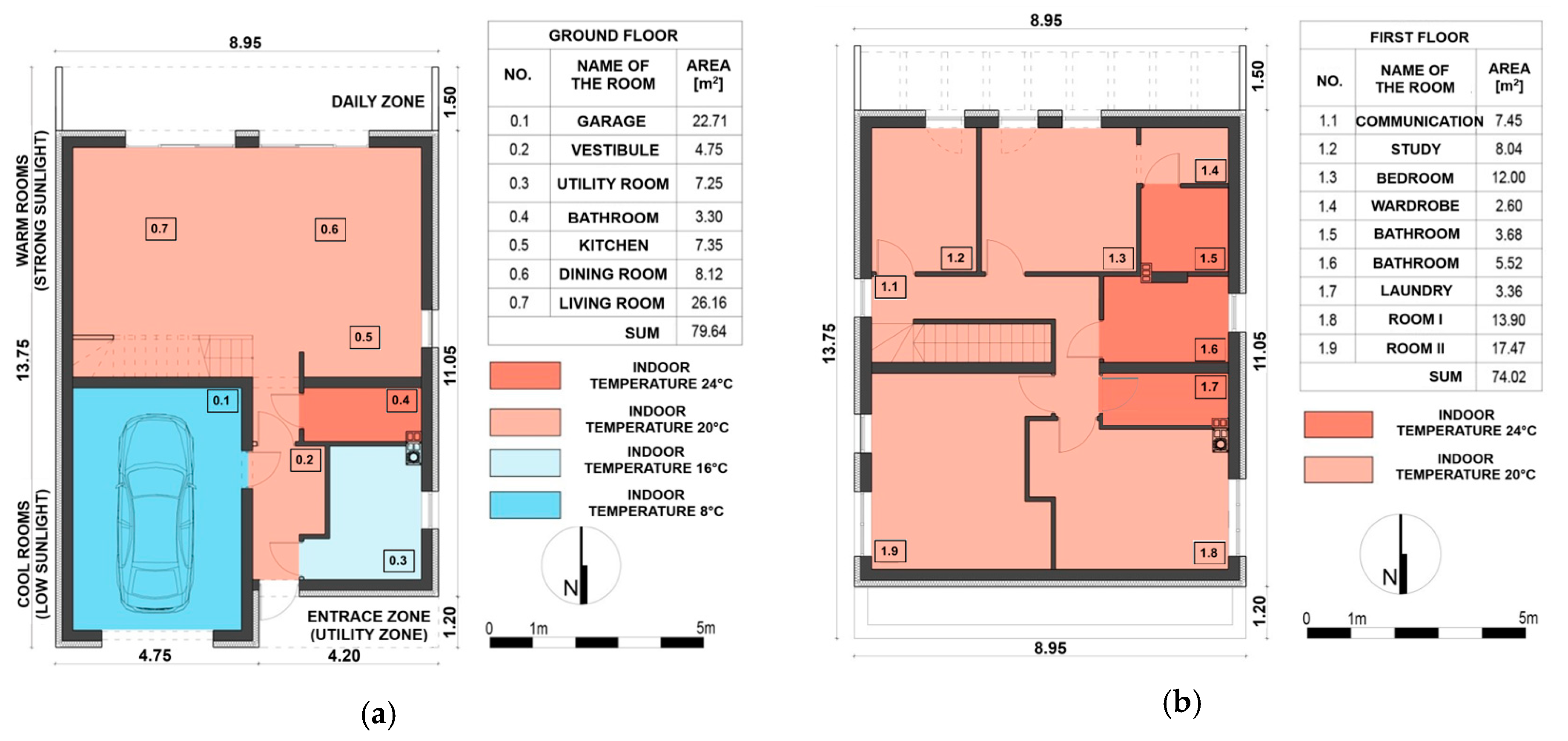
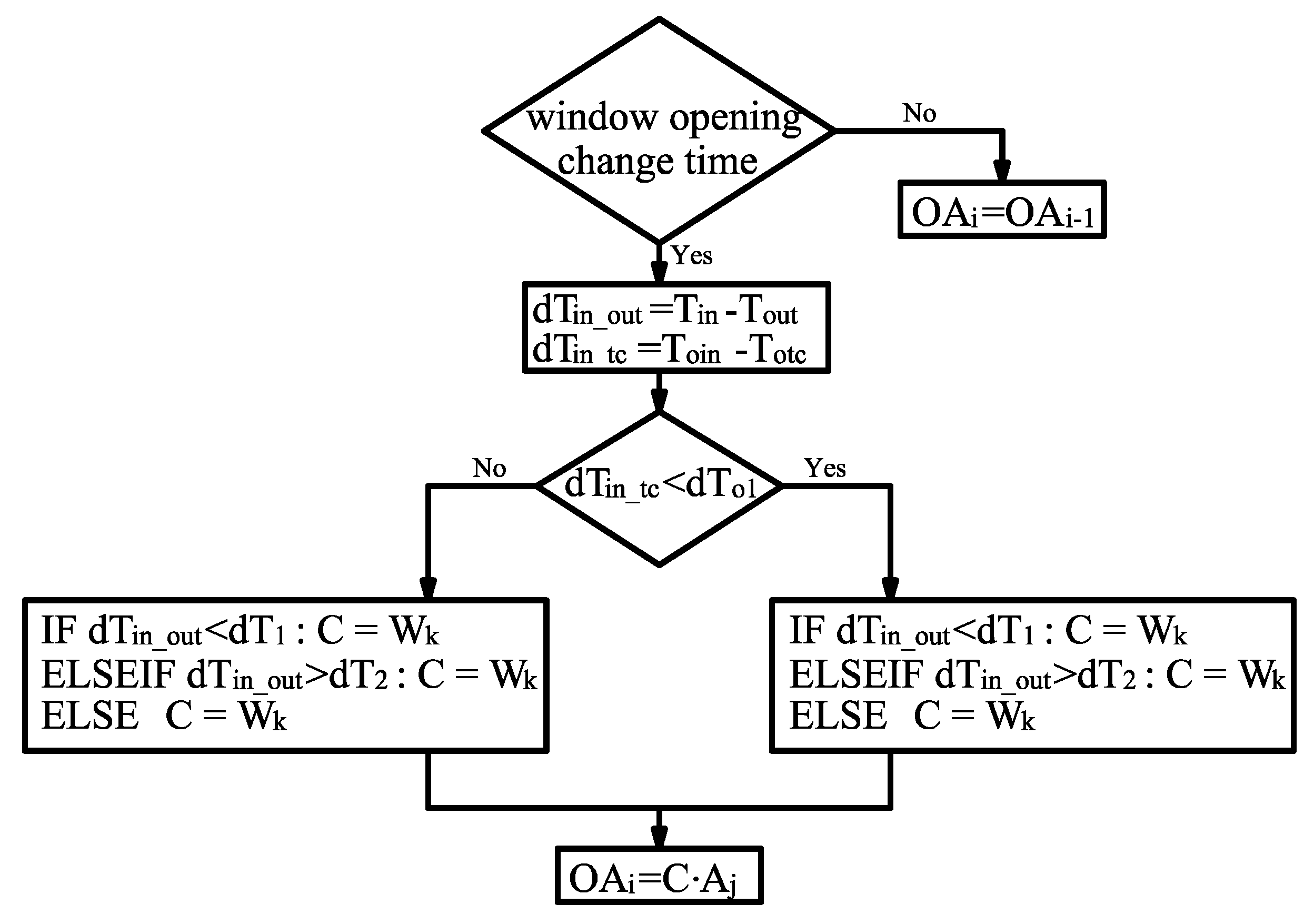
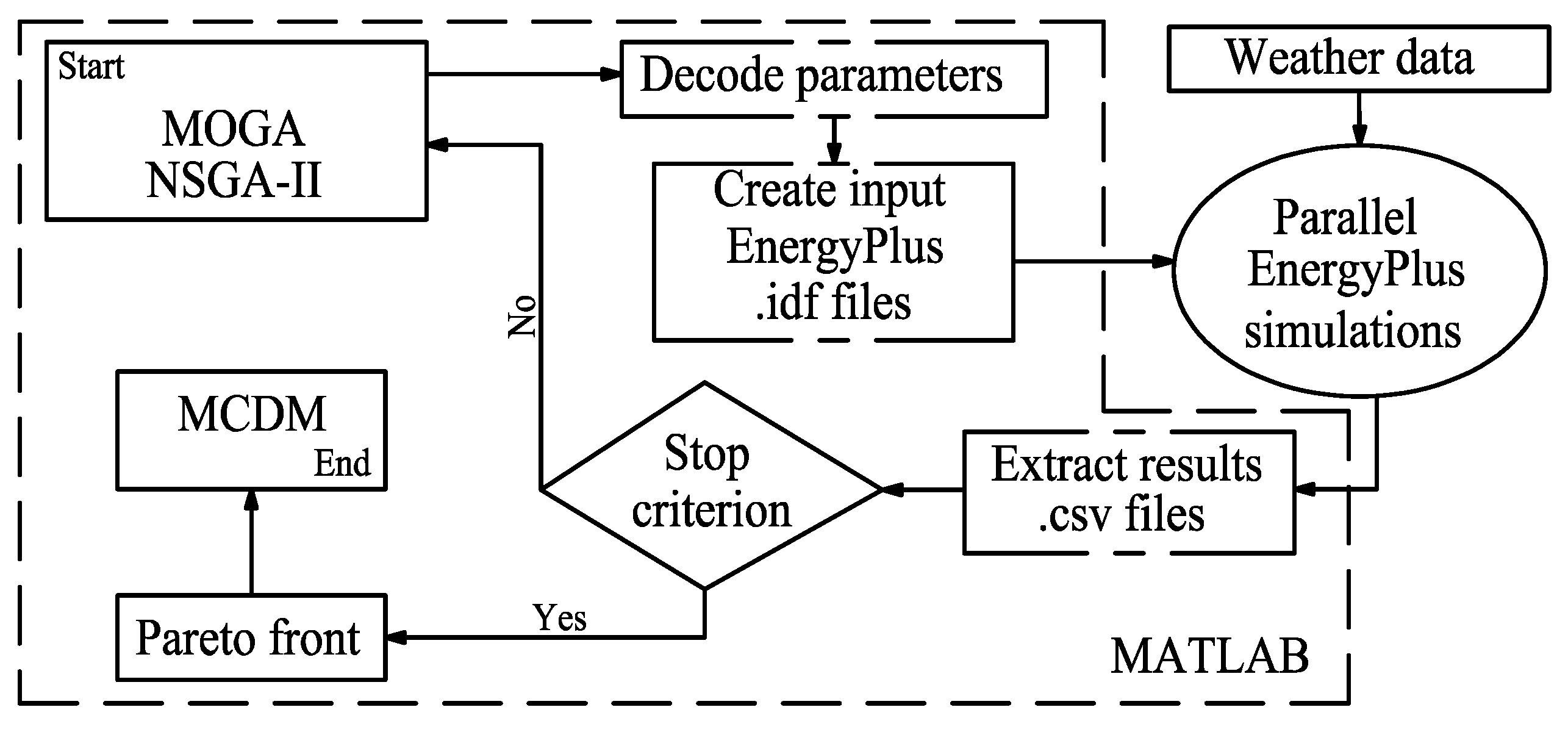
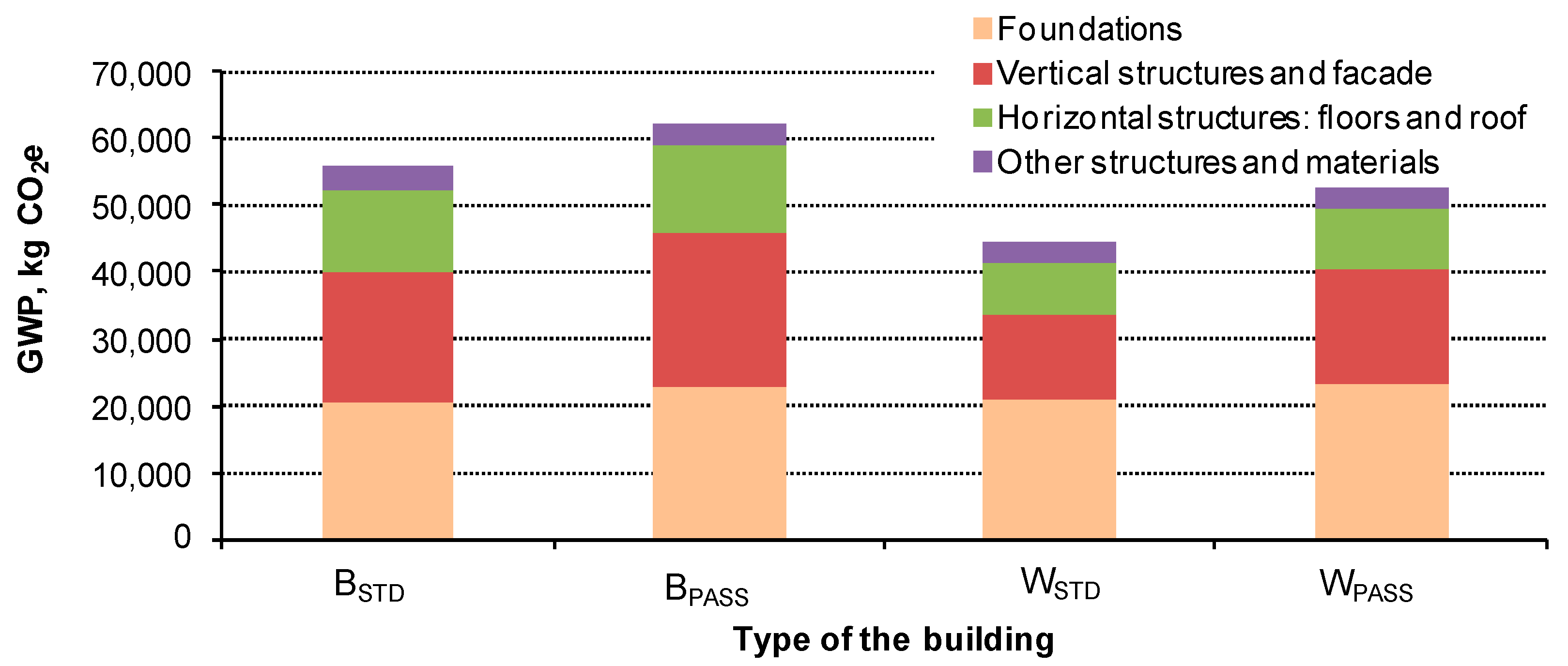
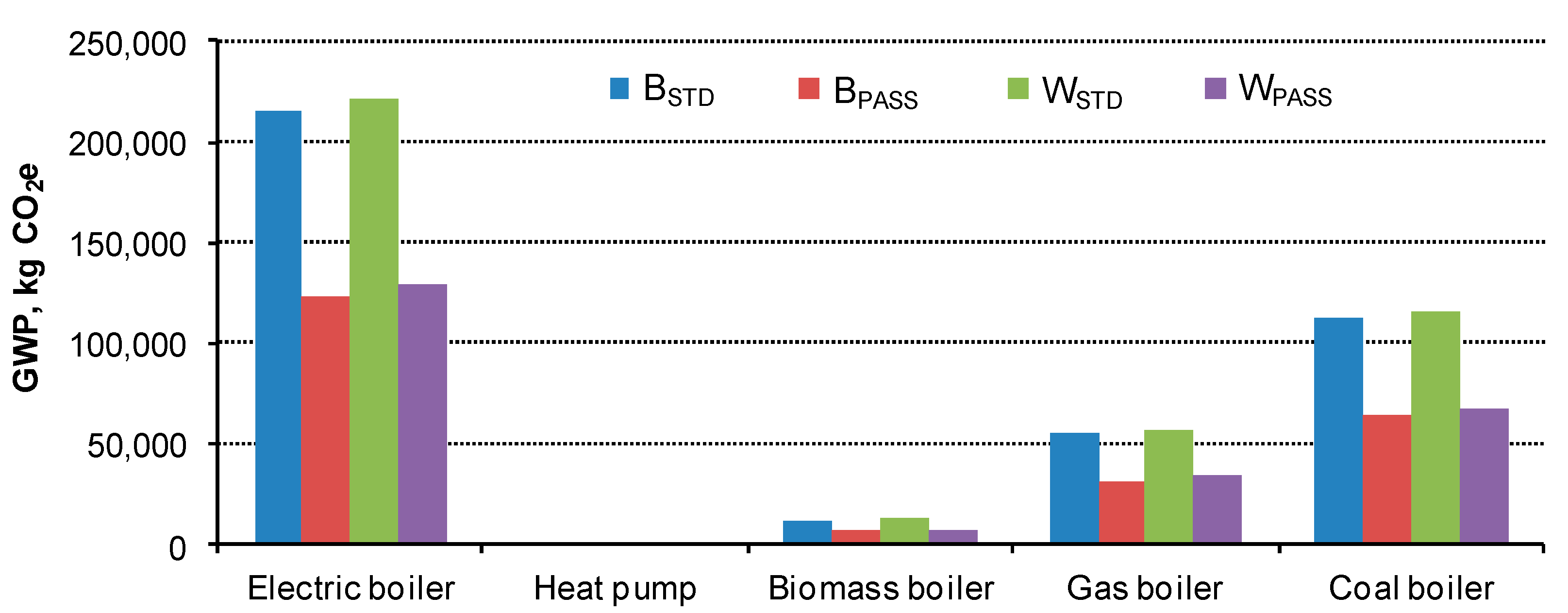
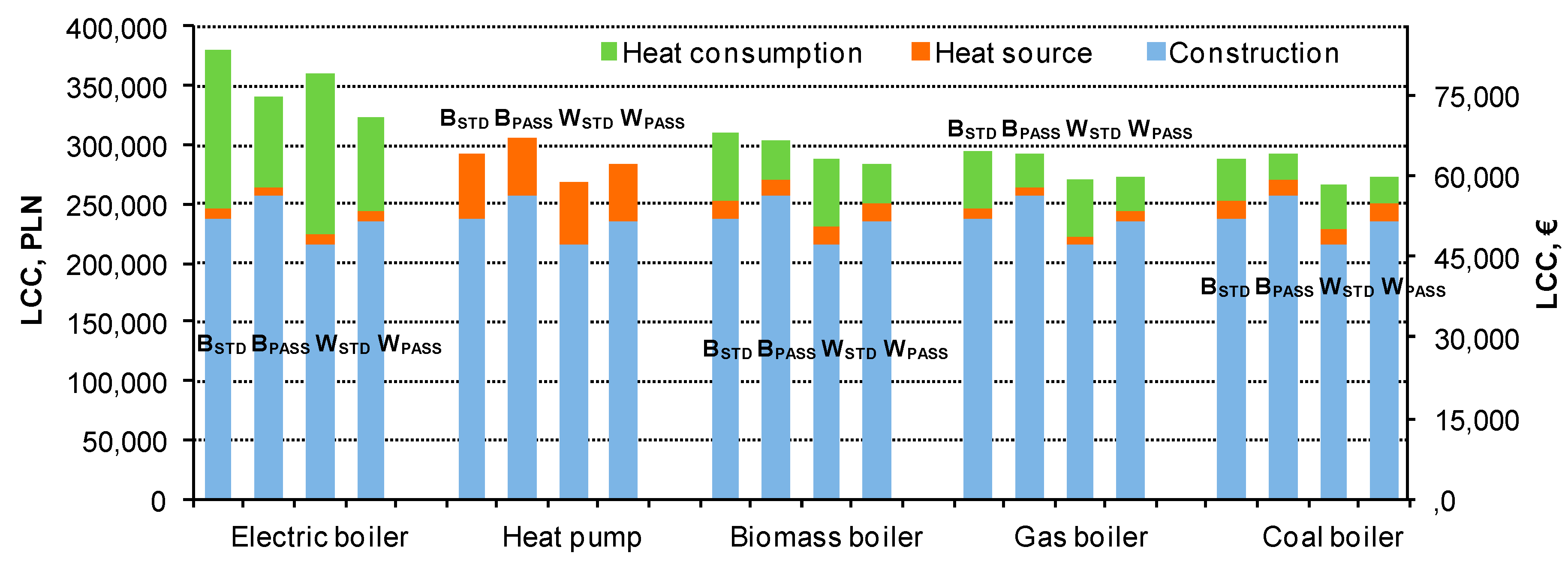
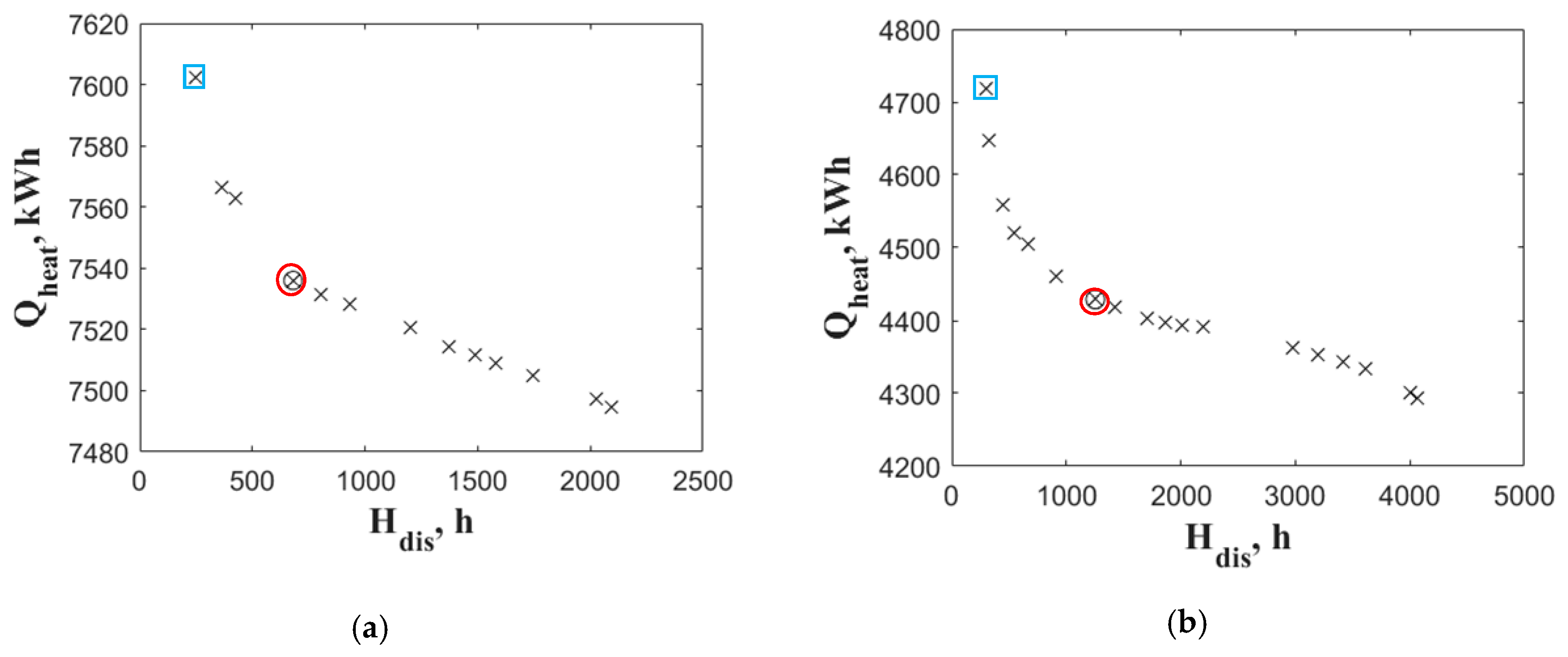
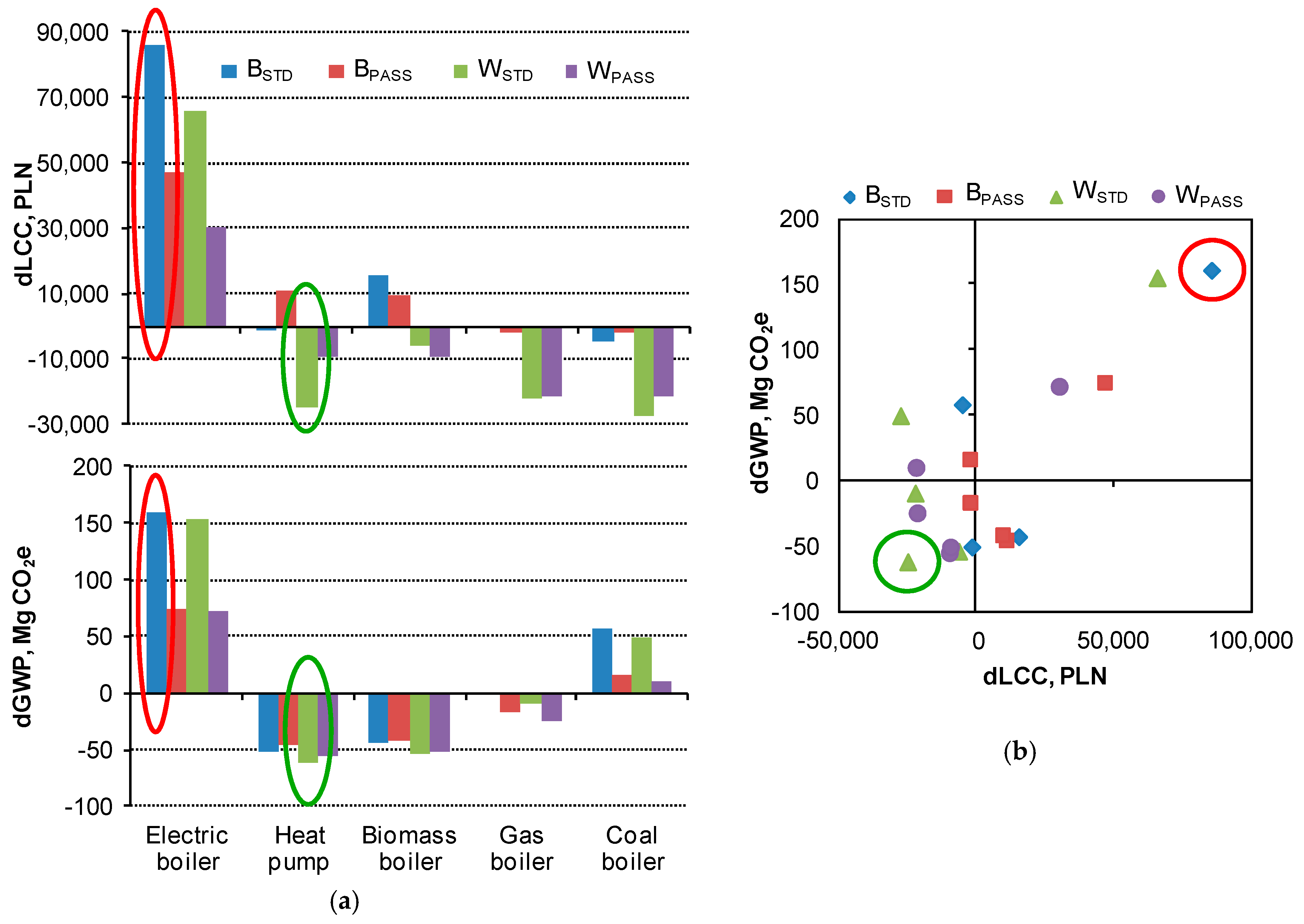
| Partition | Heat Transfer Coefficient, Uc, W/m2K | |
|---|---|---|
| BSTD and WSTD | BPASS and WPASS | |
| External wall | 0.23 | 0.10 |
| Ground floor | 0.29 | 0.11 |
| Roof | 0.18 | 0.11 |
| Roof above the garage | 0.17 | 0.11 |
| Window | 0.85 1 | 0.90 2 |
| Average annual temperature | 8.2 °C |
| Minimum annual temperature | −12.2 °C |
| Maximum annual temperature | 33.1 °C |
| Average temperature in the heating period | 5.1 °C |
| Average temperature the in summer | 17.6 °C |
| Electric Boiler | Gas Boiler | Coal Boiler | Heat Pump | Biomass Boiler | |
|---|---|---|---|---|---|
| Total efficiency of the heating system1 | 0.81 | 0.80 | 0.67 | 2.22 | 0.57 |
| Investments costs of the heat source, PLN (€) | 8300 (1820) | 8200 (1800) | 14,700 (3220) | 36,700/33,0002 (8040/7230) | 15,000 (3290) |
| GWP, kgCO2e /kWh | 0.95 | 0.24 | 0.41 | 0.003 | 0.036 |
| Building | Materials, PLN (€) | Labor, PLN (€) | Use of Equipment on the Construction Site, PLN (€) |
|---|---|---|---|
| BSTD | 180,200 (39,480) | 53,800 (11,790) | 4300 (940) |
| BPASS | 196,700 (43,090) | 55,300 (12,120) | 4300 (940) |
| WSTD | 151,900 (33,280) | 60,000 (13,150) | 3100 (680) |
| WPASS | 171,100 (37,490) | 61,500 (13,470) | 3100 (680) |
| Building | Qheat, kWh | Hdis, h |
|---|---|---|
| BSTD | 7344 | 371 |
| BPASS | 4205 | 894 |
| WSTD | 7536 | 681 |
| WPASS | 4429 | 1253 |
| Building | Hdis, % | ACHmax, h−1 | Tmax, °C | |||
|---|---|---|---|---|---|---|
| All Year | Summer | |||||
| Max | Avg | Max | Avg | |||
| BSTD | 11.6 | 2.9 | 45.9 | 9.3 | 1.5 | 31.61 |
| BPASS | 13.6 | 7.1 | 51.1 | 26.8 | 3.8 | 33.12 |
| WSTD | 12.2 | 5.4 | 45.1 | 17.3 | 3.0 | 35.31 |
| WPASS | 18.9 | 9.9 | 58.1 | 32.8 | 3.8 | 36.42 |
© 2020 by the authors. Licensee MDPI, Basel, Switzerland. This article is an open access article distributed under the terms and conditions of the Creative Commons Attribution (CC BY) license (http://creativecommons.org/licenses/by/4.0/).
Share and Cite
Grygierek, K.; Ferdyn-Grygierek, J.; Gumińska, A.; Baran, Ł.; Barwa, M.; Czerw, K.; Gowik, P.; Makselan, K.; Potyka, K.; Psikuta, A. Energy and Environmental Analysis of Single-Family Houses Located in Poland. Energies 2020, 13, 2740. https://doi.org/10.3390/en13112740
Grygierek K, Ferdyn-Grygierek J, Gumińska A, Baran Ł, Barwa M, Czerw K, Gowik P, Makselan K, Potyka K, Psikuta A. Energy and Environmental Analysis of Single-Family Houses Located in Poland. Energies. 2020; 13(11):2740. https://doi.org/10.3390/en13112740
Chicago/Turabian StyleGrygierek, Krzysztof, Joanna Ferdyn-Grygierek, Anna Gumińska, Łukasz Baran, Magdalena Barwa, Kamila Czerw, Paulina Gowik, Klaudia Makselan, Klaudia Potyka, and Agnes Psikuta. 2020. "Energy and Environmental Analysis of Single-Family Houses Located in Poland" Energies 13, no. 11: 2740. https://doi.org/10.3390/en13112740
APA StyleGrygierek, K., Ferdyn-Grygierek, J., Gumińska, A., Baran, Ł., Barwa, M., Czerw, K., Gowik, P., Makselan, K., Potyka, K., & Psikuta, A. (2020). Energy and Environmental Analysis of Single-Family Houses Located in Poland. Energies, 13(11), 2740. https://doi.org/10.3390/en13112740









